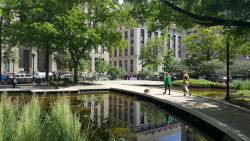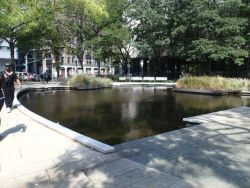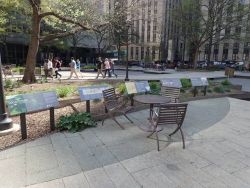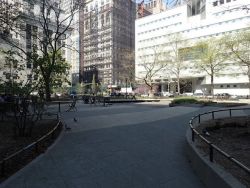Collect Pond Park
Collect Pond Park
Located on Leonard Street between Centre and Lafayette Streets, this park occupies the eighteenth century site of Collect Pond. The pond was a large, sixty-foot deep pool fed by an underground spring. The waters derived their name from seventeenth century Dutch settlers, who called it “kolch” meaning “small body of water”. Following the English capture of New Amsterdam (1664), the name was corrupted to “collect.” Throughout the seventeenth and eighteenth centuries, Collect Pond was a favorite spot for picnics and ice-skating. In 1796, John Fitch (1743-1798) launched one of the first experimental steamboats on the waters. During this time, the pond was still clean enough to use for the area’s drinking water. By the early nineteenth century, however, New York City had transformed the sparkling waters into a communal open sewer. Disgusted, local authorities initiated a project to fill the sewer with earth from an adjacent hill. In 1805, in order to drain the garbage-infested waters, designers opened a forty-foot wide canal that today is known as Canal Street.
By 1811, the City had completed the filling of Collect Pond. A neighborhood known as Paradise Square soon arose over the pond’s previous site. Unfortunately, due to the area’s extremely high water table, Paradise Square began to sink in the 1820’s. The neighborhood also began to emit a foul odor, prompting the most affluent residents to leave the community. By the 1830s, Paradise Square had become the notorious “Five Points,” an extremely poor and dangerous neighborhood renowned for its crime and filth.
Five streets comprised the “Five Points,” giving the neighborhood its name: Mulberry Street, Anthony (present-day Worth) Street, Cross (present-day Musco) Street, Orange (present-day Baxter) Street, and Little Water Street (no longer exists). Numerous criminal gangs roamed the neighborhood, extorting money from residents and running prostitution rings. Many early twentieth century criminals, such as Lucky Luciano (1897-1962) and Al Capone (1899-1947), had their start in “Five Points” street gangs. Crime was only one half of the story in the “Five Points”: the high population density of the neighborhood and the existence of a subterranean swamp precipitated the outbreak of disease. Throughout the nineteenth century, nearly all of the city’s cholera outbreaks originated in this neighborhood.
The squalid conditions of the “Five Points” soon began to end after the 1890 publication of How the Other Half Lives, by Jacob Riis (1849-1914). Riis’ work was a revealing account of slum life on the Lower East Side that disturbed late-nineteenth century reformers. Within four years of the book’s appearance, the City of New York had condemned nearly all the tenements that comprised the area, ridding the community of crime and filth. This revived area is now known as Civic Center, due to the presence of many governmental offices.
On April 28, 1960, the Board of Estimate placed the property under Parks jurisdiction. The property was formerly known as Civil Court Park due to the plethora of judiciary institutions throughout the neighborhood; the Criminal Court, Civil Court, and Family Court are all visible from this parkland. The park boasts a large, green open area circumscribed by benches and trees. Commissioner Stern changed the property’s name from Civil Court Park to Collect Pond Park, thereby providing the area with a well-deserved sense of character and history.
Check out your park's Vital Signs
Clean & Safe
Green & Resilient
Empowered & Engaged Users
Share your feedback or learn more about how this park is part of a
Vital Park System





